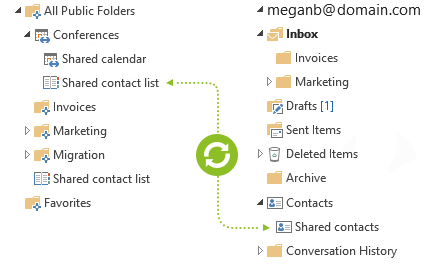CodeTwo Exchange Sync
- Synchronize Exchange folders
- Access public folders on mobile devices
- Synchronize data in real time
- For Exchange Server 2013, 2010 & 2007

This tool is deprecated, which means it’s no longer available for download, and we no longer develop, maintain, test, or support it. Because of that, we can’t guarantee it will work properly in your environment. You can see our current software products here.
Synchronization of data in two directions between mobile devices and public folders
The example given in Synchronize data between mobile devices and Exchange public folders is related to one-way synchronization – from a public contacts folder to the user's personal contacts folder. However, you may need to give the users an opportunity to update the shared contacts database stored in the public folder. For this you need to create two-way synchronization between the public folder and users' personal folders.

In the two-way synchrnization mode, any change made by any user to their personal folders or via a mobile device automatically replicates to the public folder and all the remaining personal folders included in this sync group (Folder ring).
Let's have a practical example:
A Sales reprezentative works outside the office. While having a meeting with a client, the employee sees the data in the public folder is obsolete and needs to be updated. The employee inputs up-to-date information to the smartphone. The phone uploads the data to the personal folder via Active Sync. Once the data is changed in the personal folder, CodeTwo Exchange Sync transmits it to the public folder and selected other users' personal folders.
In this scenario (two-way synchronization), all folders within one sync group are always kept in sync and have the same set of data.
If there are Sales representatives in your company who need to be able to modify items in the public contacts folder, you need to create two tasks in CodeTwo Exchange Sync. The first task will be one-way synchronization, as described in Synchronize data between mobile devices and Exchange public folders. This task will prevent changes made to the personal folder or mobile devices from syncing to the public folder. The second task will be a two-way sync, so that changes made to personal users' folders will be synced with the public folders.



